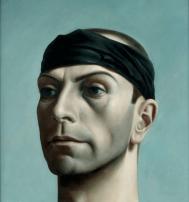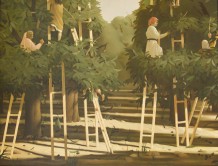Utrecht’s Centraal Museum has an interesting exhibition called “The World of Pyke Koch” till the 18th of March 2018. Pyke Koch was an important Dutch member of a group of artists creating ‘magic realistic’ works. In literature and art, the genre focuses on realistic situations which include magical, mythical elements.

Centraal Museum Utrecht, Pyke Koch’s self-portrait
Pieter F.C. Koch, Pyke Koch, came from a well-to-do family. He studied law at Utrecht’s University. Yet he never graduated. In his final university year, he decided to become an artist.
In an excerpt from an interview included in the exhibition’s official video, he explains he never regretted this choice. Not that painting made him happy. He calls it depressing and taxing work.
Pyke soon made a name by exhibiting his works. During the 1930s, he portrayed impressive women and fairground scenes. Works from this period include Mercedes of Barcelona (1930), Bertha of Antwerp (1931) and The shooting gallery (1931).
The exhibition includes works by contemporaries like Carel Willink, Raoul Hynckes, Charley Toorop, Georg Grosz, Anton Räderscheidt and Christian Schad. It seems Charley Toorop influenced Koch, but some of his subjects he shares with other magic realistic painters.
Pyke not only portrayed prostitutes and actresses, but also upper-class women. The exhibition shows a stunning portrait of his wife, a politician’s daughter.

Pyke Koch’s “Harvest” – a scene showing renaissance and Italian influences.
Many of Koch’s paintings created scandals though. There is his ‘Nocturne’ (1930) which included a public urinal; a meeting point for homosexuals. Worse was to come. As the exhibition points out, Pyke admired Fascism. He and his wife spent time in Mussolini’s Italy.
Pyke’s self-portrait, selected as exhibition poster, hints at his fascination admiration of Fascism. This admiration soon disappeared, once Germany occupied the Netherlands. Pyke severed all ties with politics and right-wing groups.
As punishment for his sympathies, Pyke was not allowed to exhibit works for a year once WWII ended. Pyke soon re-established himself.
Koch’s technique was admired from the start. He loved art from the Italian Renaissance and this shows in many of his works. Painters he admired included Piero della Francesca, as well as Henri Rousseau.
Rousseau’s painting “Sleeping Gypsy” inspired Koch to create “Resting Somnambulist”. He painted several versions between 1959 and 1971. Other later paintings include series of Rugby players.

One of Pyke Koch’s later paintings of men playing rugby
The exhibition includes Koch’s last painting. In 1980, he was diagnosed suffering from Alzheimer and he had to give up painting. He died eleven years later; a sad end to a life spent trying to create perfect, semi-realistic, yet magical scenes.
This exhibition is not just fascinating as an introduction to Pyke Koch’s world. It includes famous and important works by Koch’s contemporaries. This makes it a nice introduction to the magic realistic genre in painting.
Utrecht, Centraal Museum “The World of Pyke Koch”
YouTube: official exhibition film “The World of Pyke Koch”
